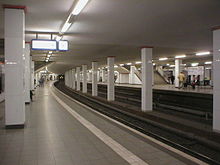Richard Brademann

Richard Brademann (* 17th May 1884 in Halberstadt , † 20th April 1965 in Berlin ) was a German architect and railways - construction officer, Mr . He created a particularly large number of railway buildings in Berlin.
Life
From 1903 Brademann studied architecture at the Technical University (Berlin-) Charlottenburg . In July 1908 he received his diploma and began a legal clerkship in the civil service. In 1913, after passing the state examination, he was appointed government builder ( assessor in the public building administration) and the next year he took a position at the Prussian Railway Administration , which was merged with the Reichsbahn in 1920 and with the Deutsche Reichsbahn in 1924 . In 1920 he became senior building officer and head of one of the three building construction departments.
Between 1922 and 1939 he designed numerous buildings for the Berlin S-Bahn and shaped them with his clear, factual, functional style. In addition to station buildings, he also built substations , signal boxes and other technical buildings there. During this time, the expansion and electrification of the Berlin city, ring and suburban railways to create an exemplary S-Bahn system at the time. Many of his buildings are still present in the Berlin cityscape today, are under monument protection and can be recognized by his special design signature. He thus had a similar influence on Berlin's railway architecture as Alfred Grenander did on Berlin's subway architecture between 1902 and 1930.
In 1931 Brademann joined the NSDAP . In April 1933 he brought to the Reich Chancellery a note, which he had at least co-authored, on "personal and factual abuses in the main administration of the Deutsche Reichsbahn-Gesellschaft". The letter contained a long list of people on the administrative board, board of directors, management and in the subsidiary companies of the Reichsbahn who were defamed as Jews, half-Jews, democrats, Marxists or Freemasons. In February 1937, Brademann reported to the Reich Ministry of Transport that his grandmother was of Jewish origin. After a statement by the Reich Office for Family Research , Adolf Hitler decreed that Brademann could remain a simple party member.
After the Second World War , Brademann, who was no longer allowed to work in the civil service, went to Yugoslavia , where he was involved in the reconstruction. He later returned to West Berlin , where he died in 1965. Richard Brademann's grave is in the Old Twelve Apostles Cemetery in Berlin-Schöneberg .
Buildings (selection)
Converter, rectifier and switchgear

- 1922–1924: Pankow converter plant
- 1922–1925: Hermsdorf converter plant
- 1924–1926: Hennigsdorf rectifier plant
- 1925–1926: Tegel rectifier plant
- 1927: rectifier plant in Saalestrasse
- 1927–1928: Halensee switchgear and rectifier plant (today also the headquarters of the Berlin S-Bahn)
- 1927–1928: Markgrafendamm switchgear and rectifier plant
- 1927–1928: Switching and rectifier plant in Ebersstrasse
- 1927–1928: rectifier and signal box in Hermannstrasse
- 1927–1928: Switching and rectifier factory in Friedrichstrasse
- 1927–1928: Niederöneweide rectifier plant
- 1927–1928: Nikolassee rectifier plant
- 1927–1928: Griebnitzsee rectifier plant (from 1996 to 2016 location of the Berlin S-Bahn Museum )
- 1928: Rectifier works in Charlottenburg (today Kunsthalle Koidl )
- 1928: Gesundbrunnen rectifier plant
- 1932–1933: Lichterfelde West rectifier plant
Station building
- 1922–1924: Warschauer Strasse station
- 1923–1924: Birkenwerder station reception building
- 1923–1926: Pedestrian bridge with entrance buildings at Ostkreuz station
- 1924: Reception building at Hohen Neuendorf station
- 1926–1928: Railway station exhibition (today Westkreuz)
- 1927–1928: Eichkamp station (today Messe Süd)
- 1927–1928: Wannsee station
- 1929: Bornholmer Strasse train station
- 1932–1933: Feuerbachstrasse railway station
- 1934: Humboldthain station
- 1939: Potsdamer Platz tunnel station (S-Bahn)
- 1939: Tunnel station Anhalter Bahnhof (S-Bahn)
Railcar hangars
- 1926–1927 Velten railcar hangar
Fonts
- Buildings of the Reichsbahn-Direktion Berlin for the electrification of the Berlin urban and suburban railway . In: Wasmuthsmonthshefte für Baukunst, vol. 13, 1929, pp. 481–493 ( digitized version of the central and regional library Berlin )
- Buildings of the electrified city and suburban railways Reichsbahndirektion Berlin . In: Zeitschrift für Bauwesen , vol. 80, 1930, pp. 25–39 ( digitized version of the Central and State Library Berlin ).
literature
- Susanne Dost: Richard Brademann (1884-1965). Architect of the Berlin S-Bahn. B. Neddermeyer, Berlin 2002, ISBN 3-933254-36-1 .
- Jan Gympel : Who was Richard Brademann? In: Berliner S-Bahn-Museum (Ed.): Caution high voltage! 75 years of the Berlin S-Bahn - power for rapid urban traffic. GVE-Verlag, Berlin 1999, ISBN 978-3-89218-175-0 , pp. 57-63.
Web links
- Literature by and about Richard Brademann in the catalog of the German National Library
- Berlin underworld: the Gesundbrunnen substation
- Koidl art gallery
- S-Bahn Berlin: Richard Brademann's Ostkreuz architecture
- S-Bahn buildings, S-Bahn pictures - report on exhibitions in the German Museum of Technology in Berlin. In: Punkt 3 of September 26, p. 2
Individual evidence
- ↑ On the whole: Alfred Gottwaldt: The Reichsbahn and the Jews 1933–1939 - Anti-Semitism on the railroad in the prewar period. Marix, Wiesbaden 2011, ISBN 978-3-86539-254-1 , pp. 71f.
- ↑ Alfred Gottwaldt, ibid, p. 224.
- ↑ knerger.de: The grave of Richard Brademann
| personal data | |
|---|---|
| SURNAME | Brademann, Richard |
| BRIEF DESCRIPTION | German architect and construction officer |
| DATE OF BIRTH | May 17, 1884 |
| PLACE OF BIRTH | Halberstadt |
| DATE OF DEATH | April 20, 1965 |
| Place of death | Berlin |


